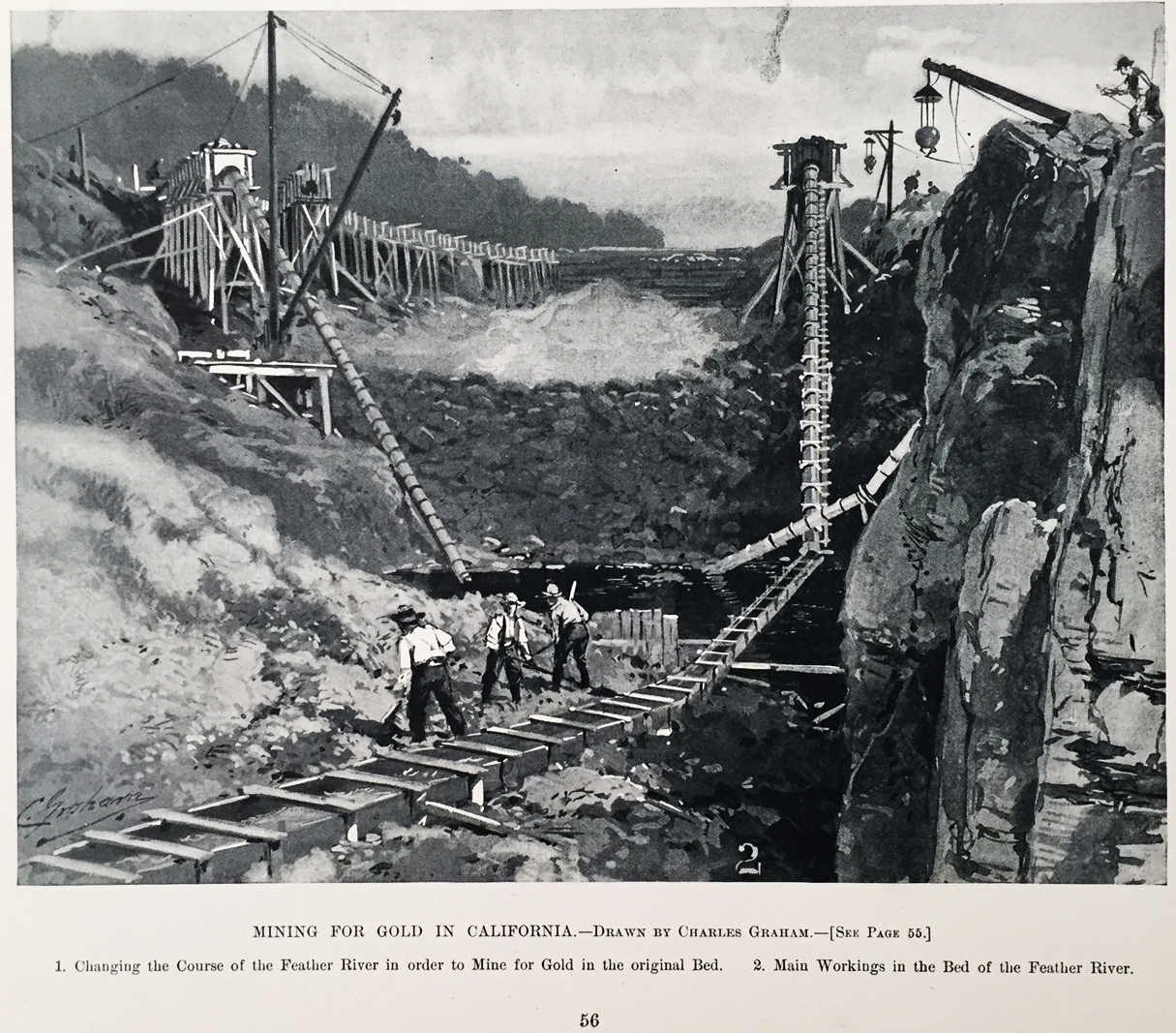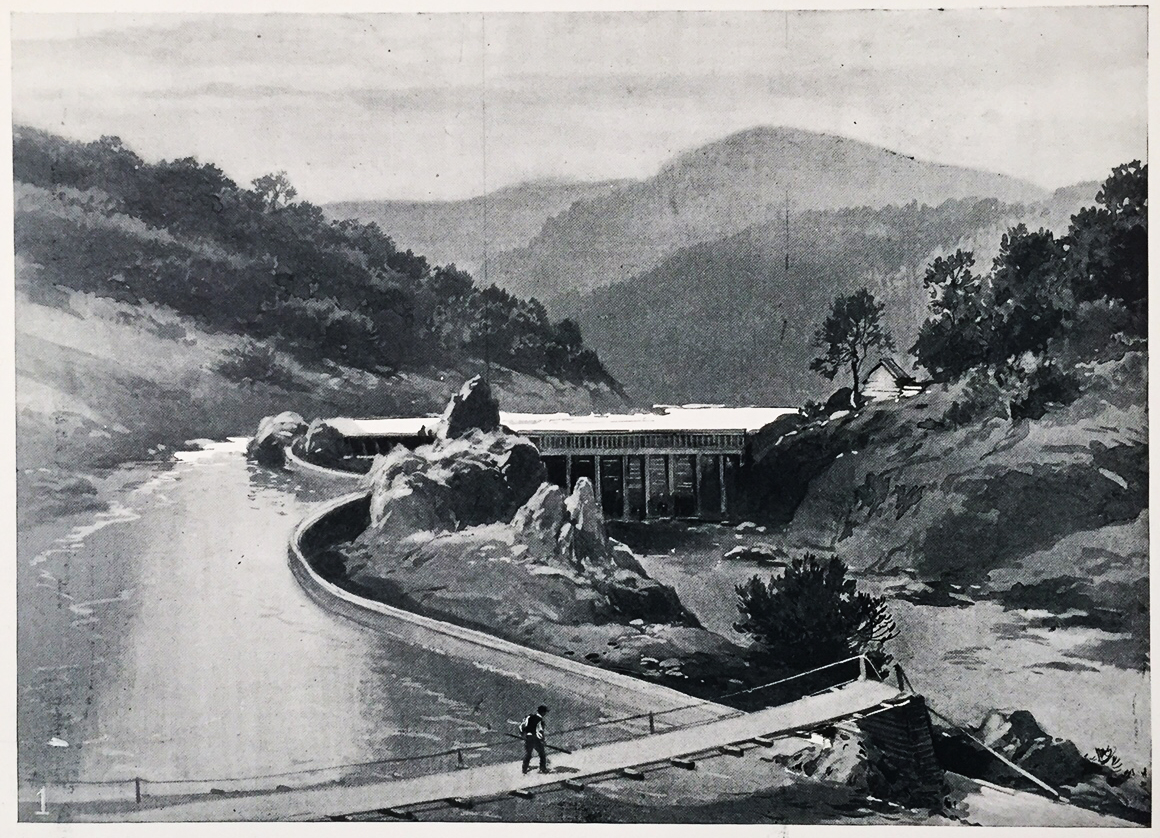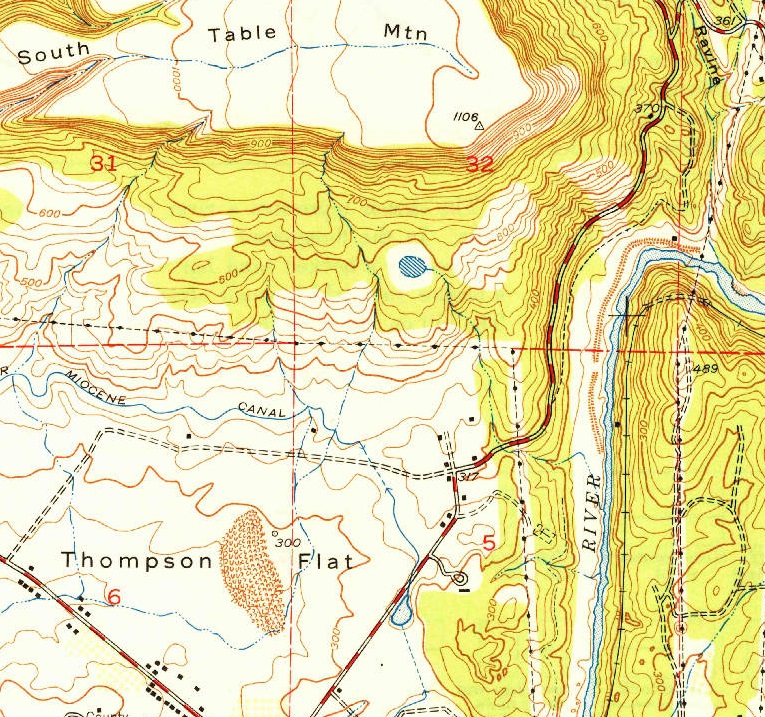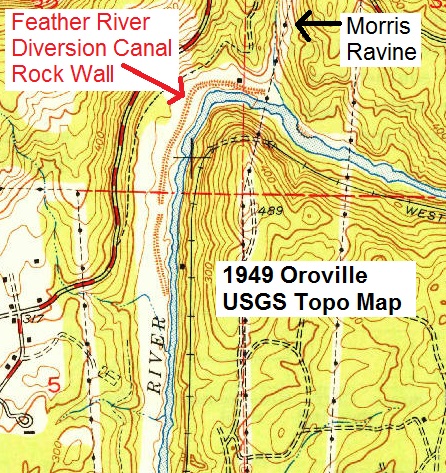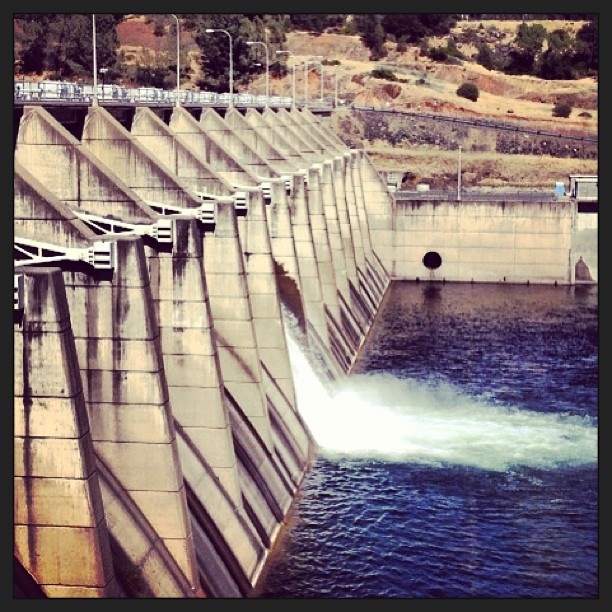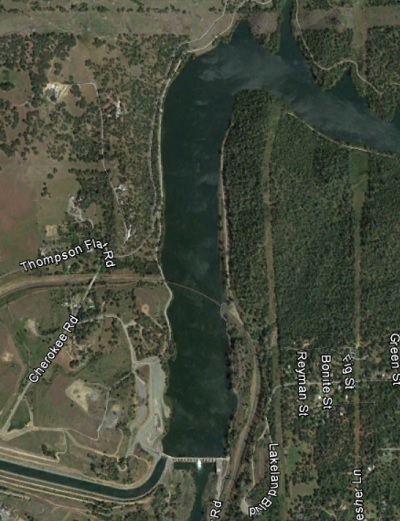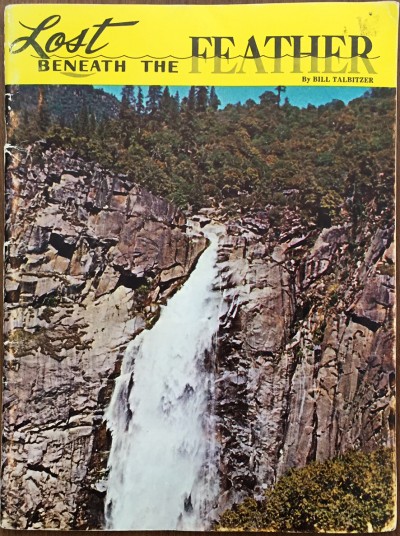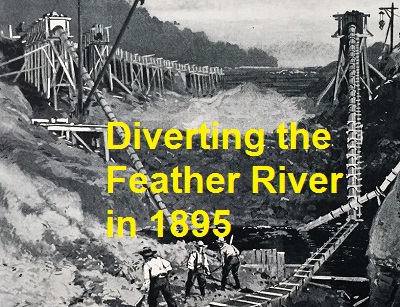
1895 diversion of the Feather River for gold mining.
So much good history is underwater. Our 20th century dam building covered in water many interesting historic artifacts such as the remnants of a 19th century dam and diversion canal on the Feather River. A small paperback titled “Lost Beneath The Feather River” and a brief story published in Harper’s Weekly clued me into this historic diversion canal and mining project.
United Kingdom invests to divert Feather River for gold
In 1892, with investment money from the United Kingdom, Frank McLaughlin began the process of diverting the Feather River in an effort to expose the river bed for gold mining. The plan was much like a typical irrigation canal diversion dam. Only instead of part of the river flow being diverted, this project diverted the entire mining season flow of the Feather River into the rock walled bypass canal. The diversion canal was two miles in length and paralleled the river. Today, all the remnants of the rock wall canal and dam are under the Thermalito lake downstream of Oroville dam.

Harper’s Weekly, 1895, illustration no. 1. Changing the course of the Feather River in order to mine for gold in the original bed.
Constructing dam, flume, and rock wall bypass
The project had three parts: the dam, a short flume from the dam, and a canal on the north west side of the Feather River constructed out of locally mined boulders. In 1895 the Feather River was diverted into the bypass canal leaving the river bed virtually dry and ready for mining. Unfortunately, the amount of gold recovered was far less than anticipated. Speculation about the paltry sum of gold recovered centered on the fact that early placer miners had already scooped up most the gold back in the 1850’s. Larger photos at end of post.
Dam destroyed, submerged underwater
The grand project to move the Feather River had cost approximately $12 million and taken four years to construct. With little prospect for recovering the investment in the project, the log dam and flume were blown up returning the Feather River to its original course. There are numerous pictures showing the project and an artist’s rendering that was run in Harper’s Weekly. The remnants of the rock bypass canal was captured in 1949 U.S. topographical map.
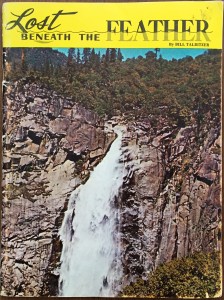
“Lost Beneath the Feather” by Bill Talbitzer, sixth printing, 1963.
Lost beneath the Feather
Lost Beneath The Feather, sixth printing, authored by Bill Talbitzer and published in 1963 first alerted me to the Feather River diversion. The 54 page Lost Beneath the Feather was written with the intent to capture the history and stories that were to be drowned with the construction of the Oroville Dam on the Feather River. While this little paperback makes a worthy effort, there are no references or a bibliography to note where all the historic content was derived. This along with the embellished writing style of Talbitzer diminishes the credibility of this little publication as a historic reference itself, save for the pictures.
Harper’s Weekly report on the grand river diversion project
This description of the construction of the Feather River diversion project comes from Harper’s Weekly. A penciled date on the page indicates it was from January 19, 1895. There is no mention of the dam and flume being blown up so I must assume the story ran before that event.
Harper’s Weekly [January 19, 1895]
The Feather River Dam
The entire eastern side of Butte County, in northern California, is formed by outrunning spurs from the western side of the Sierra Nevada Mountains, between which the different branched of the Feather River (North, Middle, and South, with their tributaries) debouch into the Sacramento Valley, after passing for the greater part of their through a rich mineral country in which gold-bearing quartz veins as well as remains of ancient river channels are abundant. These spurs contain great quantities of timber suitable for mining, while the south and west parts of the county contain as rich farming land as can be found anywhere in the State, insuring unfailing supplies for the support of large bodies of miners. Railroads extend up to the county-seat and good stage roads penetrate the foothills in different directions.
A large part of the gold production of Butte County has been derived from the Feather River and its branches, which unite about ten miles north of Oroville, the county seat, more capital has been expended in this branch of the mining of late than the development or drift or quartz mines.
An English company has constructed a dam on the main Feather River, just above the town of Oroville, for the purpose of working the auriferous gravel, and results have already been most satisfactory to the shareholder. A vast amount of preliminary work has been required, comprising the building of ten miles of substantial roads; the providing of dwellings in three separate camps capable of accommodating from 150 to 300 men, besides the necessary workshops; also the building of a canal along the right back of the Feather River forty feet wide and 6000 feet long, requiring the excavation of 50,000 cubic yards, to carry the river when turned out of its natural bed; the construction of a permanent head dam; the procuring of power. Which was obtained by utilizing the old Miocene ditch, which required five miles of iron piping; also the erection of an electric plant to enable the work to carried on at night as well as by day; and the connection of all the different points and the ditch stations with the head offices by telephone, requiring over forty miles of telephone wire.
In the construction of the canal a cemented rock wall was carried along the entire distance next [to] the river, at a width of four feet at the top and twelve feet on the bottom, reaching in places a height of over twenty feet from bed-rock, containing over 10,000 cubic yards of masonry, in the construction of which 6000 barrels of cement were consumed.
Two suspension-bridges cross the canal, giving access to the work from the shore. One of the bridges is eighty feet long, and carriers the pipe line which conveys the water-power from the Miocene ditch. A diminishing iron pipe is made use of, receding from thirty-two inches in diameter to twenty-two, constructed out of No. 14 diameter No. 12 iron. The company has the use of 1000 inches of water in return for repairing and keeping the ditch in order.
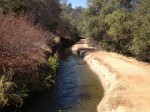
Miocene ditch flowing from Lime Saddle power house.
[The Miocene ditch was originally built to supply water to the Cherokee Hydraulic mine just north of the Feather River Dam project. It most likely had not been maintained since hydraulic mining was virtually halted in 1888 by the Sawyer Decision. See – Table Mountain Cherokee Hydraulic Mining District]
The permanent head dam extends from a rocky point at the foot of South Table Mountain to a high mass of rock near the middle of the river, and from there to the opposite shore. The first 120 feet next to the west back is occupied by the fore bay of the canal and a side dam seventy feet long providing for the wasteway. The main dam is about 144 feet long, and consists of cribs of peeled pine poles from two to twelve inches in diameter, spiked together with wrought-iron spikes (three tons were used in the construction), and filled with the heaviest rocks that the derricks could handle, quarried out of the river-banks, all surmounted by framed timers eight by eight, and crowned with a shelter dam that can be raised or lowered. This latter provision is made to meet any unexpected rise in the river. It required 70,000 feet of round timbers and 6000 cubic yards of rock in the construction, and has a height of fifty-two feet. The water-slope is doubly planked with two-inch boards. The upstream slope is boarded and made tight by slicing in sand, earth, and gravel from the banks. The dam is provided with a water cushion and everything done for the security of the work and knowledge and experience could suggest.
To prevent damage to the head of the canal by the waters coming down Morris Ravine in the spring of the year, it became necessary to wing dam the mouth of that gulch. A subflume is built along the east back, discharging over the end of the dam.
Two hydraulic elevators are used, which are supplied with power from a reservoir in the adjoining foothills, whose lifting power with 1000 inches of water under a head of 480 feet [206 PSI] amounts to 540,000 gallons an hour, discharging into the subflume. Two hundred cubic yards are raised by the larger elevator per hour, on a slope of forty-two degrees, to a height of forty-five feet. The elevator is twenty inched in diameter, with a four-and-a-half-inch nozzle.
The gold found in this part of the river during the preparatory work along the rim is fine and thin, somewhat like cucumber seed, and sells for $18.50 per ounce.
Ironically, the Feather River would once again be damned and diverted sixty years later by California’s State Water Project.


